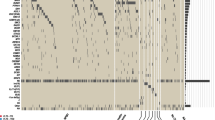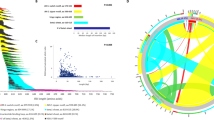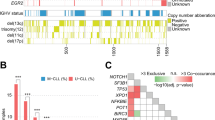Abstract
Internal tandem duplications (ITDs) of the FLT3 gene have been observed in about 35% of APL cases. If FLT3-ITD is associated with a worse outcome in patients with acute myeloid leukemia (AML) in general, its prognostic value in acute promyelocytic leukemia (APL) is still a matter of debate. We investigated incidence, associated clinical features, and prognostic implication of FLT3-ITD, but also FLT3-D835 point mutation and N-Ras or K-Ras mutations in 119 APL patients, all prospectively enrolled in the two consecutive APL-93 and APL-2000 trials. Mutation incidences were 38, 20, and 4%, for FLT3-ITD, FLT3-D835, and Ras, respectively. The presence of FLT3-ITD was associated with high white blood cell count, high Sanz index, M3-variant subtype, and V/S PML-RARα isoforms. Complete remission (CR), induction death, and death in CR rates were not affected by FLT3 or Ras mutations, as well as cumulative incidence of relapse. However, a trend for a shorter overall survival (P=0.09) was observed in FLT3-ITD patients, because of a very poor postrelapse survival (P=0.02). This feature, which has been also reported in patients with AML in general, is suggestive of an underlying genetic instability in FLT3-ITD patients, leading to the acquisition of additional unknown bad-prognosis gene mutations at relapse.
This is a preview of subscription content, access via your institution
Access options
Subscribe to this journal
Receive 12 print issues and online access
$259.00 per year
only $21.58 per issue
Buy this article
- Purchase on Springer Link
- Instant access to full article PDF
Prices may be subject to local taxes which are calculated during checkout


Similar content being viewed by others
References
Kottaridis PD, Gale RE, Linch DC . Flt3 mutations and leukaemia. Br J Haematol 2003; 122: 523–538.
Radich JP, Kopecky KJ, Willman CL, Weick J, Head D, Appelbaum F et al. N-ras mutations in adult de novo acute myelogenous leukemia: prevalence and clinical significance. Blood 1990; 76: 801–807.
Kiyoi H, Naoe T, Nakano Y, Yokota S, Minami S, Miyawaki S et al. Prognostic implication of FLT3 and N-RAS gene mutations in acute myeloid leukemia. Blood 1999; 93: 3074–3080.
Stirewalt DL, Kopecky KJ, Meshinchi S, Appelbaum FR, Slovak ML, Willman CL et al. FLT3, RAS, and TP53 mutations in elderly patients with acute myeloid leukemia. Blood 2001; 97: 3589–3595.
Yokota S, Kiyoi H, Nakao M, Iwai T, Misawa S, Okuda T et al. Internal tandem duplication of the FLT3 gene is preferentially seen in acute myeloid leukemia and myelodysplastic syndrome among various hematological malignancies. A study on a large series of patients and cell lines. Leukemia 1997; 11: 1605–1609.
Kiyoi H, Naoe T, Yokota S, Nakao M, Minami S, Kuriyama K et al. Internal tandem duplication of FLT3 associated with leukocytosis in acute promyelocytic leukemia. Leukemia Study Group of the Ministry of Health and Welfare (Kohseisho). Leukemia 1997; 11: 1447–1452.
Yamamoto Y, Kiyoi H, Nakano Y, Suzuki R, Kodera Y, Miyawaki S et al. Activating mutation of D835 within the activation loop of FLT3 in human hematologic malignancies. Blood 2001; 97: 2434–2439.
Fröhling S, Schlenk RF, Breitruck J, Benner A, Kreitmeier S, Tobis K et al. Prognostic significance of activating FLT3 mutations in younger adults (16 to 60 years) with acute myeloid leukemia and normal cytogenetics: a study of the AML Study Group Ulm. Blood 2002; 100: 4372–4380.
Liang DC, Shih LY, Hung IJ, Yang CP, Chen SH, Jaing TH et al. FLT3-TKD mutation in childhood acute myeloid leukemia. Leukemia 2003; 17: 883–886.
Sheikhha MH, Awan A, Tobal K, Liu Yin JA . Prognostic significance of FLT3 ITD and D835 mutations in AML patients. Hematol J 2003; 4: 41–46.
Andersson A, Johansson B, Lassen C, Mitelman F, Billström R, Fioretos T . Clinical impact of internal tandem duplications and activating point mutations in FLT3 in acute myeloid leukemia in elderly patients. Eur J Haematol 2004; 72: 307–313.
Schnittger S, Schoch C, Dugas M, Kern W, Staib P, Wuchter C et al. Analysis of FLT3 length mutations in 1003 patients with acute myeloid leukemia: correlation to cytogenetics, FAB subtype, and prognosis in the AMLCG study and usefulness as a marker for the detection of minimal residual disease. Blood 2002; 100: 59–66.
Thiede C, Steudel C, Mohr B, Schaich M, Schäkel U, Platzbecker U et al. Analysis of FLT3-activating mutations in 979 patients with acute myelogenous leukemia: association with FAB subtypes and identification of subgroups with poor prognosis. Blood 2002; 99: 4326–4335.
Ciolli S, Vannucchi AM, Leoni F, Nozzoli C, Longo G, Salati A et al. Internal tandem duplications of Flt3 gene (Flt3/ITD) predicts a poor post-remission outcome in adult patients with acute non-promyelocytic leukemia. Leuk Lymphoma 2004; 45: 73–78.
Beran M, Luthra R, Kantarjian H, Estey E . FLT3 mutation and response to intensive chemotherapy in young adult and elderly patients with normal karyotype. Leuk Res 2004; 28: 547–550.
Boissel N, Cayuela JM, Preudhomme C, Thomas X, Grardel N, Fund X et al. Prognostic significance of FLT3 internal tandem repeat in patients with de novo acute myeloid leukemia treated with reinforced courses of chemotherapy. Leukemia 2002; 16: 1699–1704.
Kondo M, Horibe K, Takahashi Y, Matsumoto K, Fukuda M, Inaba J et al. Prognostic value of internal tandem duplication of the FLT3 gene in childhood acute myelogenous leukemia. Med Pediatr Oncol 1999; 33: 525–529.
Liang DC, Shih LY, Hung IJ, Yang CP, Chen SH, Jaing TH et al. Clinical relevance of internal tandem duplication of the FLT3 gene in childhood acute myeloid leukemia. Cancer 2002; 94: 3292–3298.
Moreno I, Martín G, Bolufer P, Barragán E, Rueda E, Román J et al. Incidence and prognostic value of FLT3 internal tandem duplication and D835 mutations in acute myeloid leukemia. Haematologica 2003; 88: 19–24.
Steudel C, Wermke M, Schaich M, Schäkel U, Illmer T, Ehninger G et al. Comparative analysis of MLL partial tandem duplication and FLT3 internal tandem duplication mutations in 956 adult patients with acute myeloid leukemia. Genes Chromosomes Cancer 2003; 37: 237–251.
Libura M, Asnafi V, Tu A, Delabesse E, Tigaud I, Cymbalista F et al. FLT3 and MLL intragenic abnormalities in AML reflect a common category of genotoxic stress. Blood 2003; 102: 2198–2204.
Valk PJ, Bowen DT, Frew ME, Goodeve AC, Löwenberg B, Reilly JT . Second hit mutations in the RTK/RAS signaling pathway in acute myeloid leukemia with inv(16). Haematologica 2004; 89: 106.
Iwai T, Yokota S, Nakao M, Okamoto T, Taniwaki M, Onodera N et al. Internal tandem duplication of the FLT3 gene and clinical evaluation in childhood acute myeloid leukemia. The Children's Cancer and Leukemia Study Group, Japan. Leukemia 1999; 13: 38–43.
Rombouts WJ, Blokland I, Löwenberg B, Ploemacher RE . Biological characteristics and prognosis of adult acute myeloid leukemia with internal tandem duplications in the Flt3 gene. Leukemia 2000; 14: 675–683.
Meshinchi S, Woods WG, Stirewalt DL, Sweetser DA, Buckley JD, Tjoa TK et al. Prevalence and prognostic significance of Flt3 internal tandem duplication in pediatric acute myeloid leukemia. Blood 2001; 97: 89–94.
Kottaridis PD, Gale RE, Frew ME, Harrison G, Langabeer SE, Belton AA et al. The presence of a FLT3 internal tandem duplication in patients with acute myeloid leukemia (AML) adds important prognostic information to cytogenetic risk group and response to the first cycle of chemotherapy: analysis of 854 patients from the United Kingdom Medical Research Council AML 10 and 12 trials. Blood 2001; 98: 1752–1759.
Whitman SP, Archer KJ, Feng L, Baldus C, Becknell B, Carlson BD et al. Absence of the wild-type allele predicts poor prognosis in adult de novo acute myeloid leukemia with normal cytogenetics and the internal tandem duplication of FLT3: a cancer and leukemia group B study. Cancer Res 2001; 61: 7233–7239.
Zwaan CM, Meshinchi S, Radich JP, Veerman AJ, Huismans DR, Munske L et al. FLT3 internal tandem duplication in 234 children with acute myeloid leukemia (AML): prognostic significance and relation to cellular drug resistance. Blood 2003; 102: 2387–2394.
Abu-Duhier FM, Goodeve AC, Wilson GA, Gari MA, Peake IR, Rees DC et al. FLT3 internal tandem duplication mutations in adult acute myeloid leukaemia define a high-risk group. Br J Haematol 2000; 111: 190–195.
Neubauer A, Dodge RK, George SL, Davey FR, Silver RT, Schiffer CA et al. Prognostic importance of mutations in the ras proto-oncogenes in de novo acute myeloid leukemia. Blood 1994; 83: 1603–1611.
Coghlan DW, Morley AA, Matthews JP, Bishop JF . The incidence and prognostic significance of mutations in codon 13 of the N-ras gene in acute myeloid leukemia. Leukemia 1994; 8: 1682–1687.
Fenaux P, Chastang C, Chevret S, Sanz M, Dombret H, Archimbaud E et al. A randomized comparison of all transretinoic acid (ATRA) followed by chemotherapy and ATRA plus chemotherapy and the role of maintenance therapy in newly diagnosed acute promyelocytic leukemia. The European APL Group. Blood 1999; 94: 1192–1200.
Fenaux P, Le Deley MC, Castaigne S, Archimbaud E, Chomienne C, Link H et al. Effect of all transretinoic acid in newly diagnosed acute promyelocytic leukemia. Results of a multicenter randomized trial. European APL 91 Group. Blood 1993; 82: 3241–3249.
Gabert J, Beillard E, van der Velden VH, Bi W, Grimwade D, Pallisgaard N et al. Standardization and quality control studies of real-time quantitative reverse transcriptase polymerase chain reaction of fusion gene transcripts for residual disease detection in leukemia – a Europe Against Cancer program. Leukemia 2003; 17: 2318–2357.
Abu-Duhier FM, Goodeve AC, Wilson GA, Care RS, Peake IR, Reilly JT . Genomic structure of human FLT3: implications for mutational analysis. Br J Haematol 2001; 113: 1076–1077.
Kaplan E, Meier P . Nonparametric estimation from incomplete observations. J Am Stat Assoc 1958; 53: 457–481.
Peto R, Peto J . Asymptotically efficient rank invariant test procedures. J Roy Stat Soc 1972; 135: 185–206.
Gray RJ . A class of k-sample tests for comparing the cumulative incidence of a competing risk. Ann Stat 1998; 16: 1141–1154.
Fine JP, Gray RJ . A proportional hazards model for the subdistribution of a competing risk. JASA 1999; 94: 496–509.
Sanz MA, Lo Coco F, Martín G, Avvisati G, Rayón C, Barbui T et al. Definition of relapse risk and role of nonanthracycline drugs for consolidation in patients with acute promyelocytic leukemia: a joint study of the PETHEMA and GIMEMA cooperative groups. Blood 2000; 96: 1247–1253.
Kainz B, Heintel D, Marculescu R, Schwarzinger I, Sperr W, Le T et al. Variable prognostic value of FLT3 internal tandem duplications in patients with de novo AML and a normal karyotype, t(15;17), t(8;21) or inv(16). Hematol J 2002; 3: 283–289.
Noguera NI, Breccia M, Divona M, Diverio D, Costa V, De Santis S et al. Alterations of the FLT3 gene in acute promyelocytic leukemia: association with diagnostic characteristics and analysis of clinical outcome in patients treated with the Italian AIDA protocol. Leukemia 2002; 16: 2185–2189.
Arrigoni P, Beretta C, Silvestri D, Rossi V, Rizzari C, Valsecchi MG et al. FLT3 internal tandem duplication in childhood acute myeloid leukaemia: association with hyperleucocytosis in acute promyelocytic leukaemia. Br J Haematol 2003; 120: 89–92.
Shih LY, Kuo MC, Liang DC, Huang CF, Lin TL, Wu JH et al. Internal tandem duplication and Asp835 mutations of the FMS-like tyrosine kinase 3 (FLT3) gene in acute promyelocytic leukemia. Cancer 2003; 98: 1206–1216.
Longo L, Trecca D, Biondi A, Lo Coco F, Grignani F, Maiolo AT et al. Frequency of RAS and p53 mutations in acute promyelocytic leukemias. Leuk Lymphoma 1993; 11: 405–410.
Kottaridis PD, Gale RE, Langabeer SE, Frew ME, Bowen DT, Linch DC . Studies of FLT3 mutations in paired presentation and relapse samples from patients with acute myeloid leukemia: implications for the role of FLT3 mutations in leukemogenesis, minimal residual disease detection, and possible therapy with FLT3 inhibitors. Blood 2002; 100: 2993–2998.
Tiesmeier J, Müller-Tidow C, Westermann A, Czwalinna A, Hoffmann M, Krauter J et al. Evolution of FLT3-ITD and D835 activating point mutations in relapsing acute myeloid leukemia and response to salvage therapy. Leukemia Res 2004; 28: 1069–1074.
Author information
Authors and Affiliations
Consortia
Corresponding author
Appendix A APL-93 and/or APL-2000 investigators
Appendix A APL-93 and/or APL-2000 investigators
French group: Caillères (Aix-en-Provence), Desablens (Amiens), Gardembas, Hunault, Ifrah (Angers), Martin, Corront (Annecy), Dor (Antibes), Sutton, Pulik (Argenteuil), Lepeu (Avignon), Renoux (Bayonne), Deconinck (Besancon), Ades, Gardin, Casassus, Fenaux (Bobigny), Pigneux, Boiron, Reiffers (Bordeaux), Abgrall, Berthou (Brest), Reman, Leporrier (Caen), Deveaux, Salles (Chalon-sur-Saone), de Revel, Nedellec (Clamart), Plagne, Legros, Travade (Clermont-Ferrand), Gardin (Clichy), Audhuy (Colmart), Decaudin, Dutel (Compiegne), Pautas, Cordonnier, Reyes (Creteil), Caillot, Guy (Dijon), Cahn, Sotto (Grenoble), Durand (Le Havre), Solal-Celigny (Le Mans), Tertian (Kremlin-Bicetre), Morel (Lens), Nelken, de Botton (Lille), Turlure, Bordessoule (Limoges), Thomas, Archimbaud, Bastion, Michallet, Fière, Coiffier, Philippe (Lyon), Stoppa, Bouabdallah, Vey, Blaise (Marseille), Benothman, Allard (Meaux), Christian (Metz), Margueritte, Fegueux, Rossi Donadio (Montpellier), Ojeda, Henon (Mulhouse), Guerci, Witz (Nancy), Harousseau (Nantes), Pesce, Gratecos, Cassuto (Nice), Schoenwald (Orleans), Dreyfus (Paris Cochin), Vilmer (Paris Robert-Debre), Marie, Vekhoff (Paris Hotel Dieu), Buzyn, Lefrère, Varet (Paris Necker), Vernant (Paris Pitie-Salpetriere), Isnard, Gorin, Najman (Paris Saint-Antoine), Dombret, Raffoux, Gisselbrecht, Marolleau, Baruchel, Degos (Paris Saint-Louis), Leverger (Paris Trousseau), Vaque, Quetin (Point-a-Pitre), Guilhot (Poitiers), Pignon (Reims), Grosbois, Lamy, Le Prisé (Rennes), Stamatoulas, Tilly (Rouen), Bourquard (Saint-Brieuc), Janvier (Saint-Cloud), Guyotat (Saint-Etienne), Maloisel (Strasbourg), Jaubert (Toulon), Huguet, Attal, Pris, Robert, Despax (Toulouse), Colombat (Tours), Simon, Pollet (Valenciennes), Castaigne (Versailles), Bourhis, Machover (Villejuif).
Spanish group: Villegas (Almeria), Zuazu (Barcelona), Torres Carrete, Deben (Juan Canalejo), Javier de la Serna, Odriozola, Gomez-Sanz (Madrid), Rayon (Oviedo), Besalduch (Palma de Mallorca), San Miguel (Salamanca), Condé (Santander), Perez Encinas (Santiago), Sanz, Martin, Montagud (Valencia), Palomera (Zaragoza).
German group: Soucek (Dresden), Strobel (Erlangen), Ganser (Frankfurt), Brennscheidt (Freiburg), Link (Hanover), Wandt (Nurnberg), Breitenbach (Stuttgart), Herrmann (Ulm).
Swiss group: Wernli, Bargetzi (Aarau), Meyer-Monard, Ticheli, Gratwohl (Basel), Pabst, Fey, Zenhäusern (Bern), Wuillemin, Gregor (Luzern), Hess, Hitz (St Gallen), Fehr, Jacky, Taverna (Zürich), Chapuis, Starobinski (Genève), Cavalli, Ghielmini (Bellinzona), Schapira, Grob, von Fliedner (Lausanne).
Belgian group: Meeus (Anvers), Ferrant (Brussels), Boulet (Mons), Bosly (Yvoir).
Dutch group: Daenen (Griningen), Muus (Nijmegen).
Rights and permissions
About this article
Cite this article
Callens, C., Chevret, S., Cayuela, JM. et al. Prognostic implication of FLT3 and Ras gene mutations in patients with acute promyelocytic leukemia (APL): a retrospective study from the European APL Group. Leukemia 19, 1153–1160 (2005). https://doi.org/10.1038/sj.leu.2403790
Received:
Accepted:
Published:
Issue Date:
DOI: https://doi.org/10.1038/sj.leu.2403790
Keywords
This article is cited by
-
A novel RARA–SNX15 fusion in PML–RARA-positive acute promyelocytic leukemia with t(11;17;15)(q13;q21.2;q24.1)
International Journal of Hematology (2022)
-
Higher Level of Peripheral Blood CD34 Positive Cells Presented with Unfavorable Prognosis in Intermediate-Low Risk Acute Promyelocytic Leukemia
Indian Journal of Hematology and Blood Transfusion (2020)
-
The genetics and clinical characteristics of children morphologically diagnosed as acute promyelocytic leukemia
Leukemia (2019)
-
High-risk acute promyelocytic leukemia with unusual T/myeloid immunophenotype successfully treated with ATRA and arsenic trioxide-based regimen
Journal of Hematopathology (2018)
-
Comprehensive mutational analysis of primary and relapse acute promyelocytic leukemia
Leukemia (2016)



